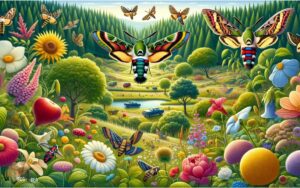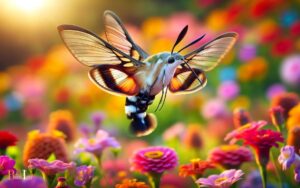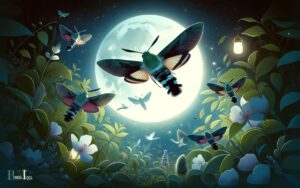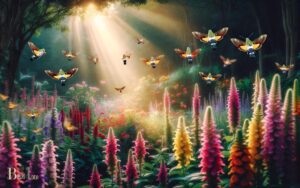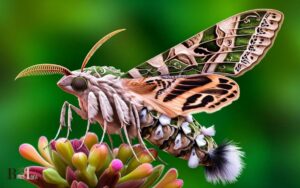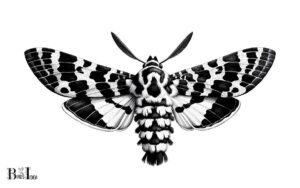Night Blooming Flower That Attracts Hummingbird Moths!
Night blooming flowers, like the evening primrose, open their petals at dusk, resembling a delicate ballet of nature.
These enchanting blooms not only captivate the eye, but also serve as a magnetic force for hummingbird moths.
These remarkable creatures, with their hummingbird-like appearance, are drawn to the sweet nectar of these nocturnal flowers, making for an awe-inspiring sight in the moonlit garden.
With their ability to thrive in the cooler evening temperatures, these flowers provide a vital food source for these fascinating moths, playing a crucial role in their ecosystem.
Understanding the allure of night blooming flowers and the enchanting dance of hummingbird moths among them adds a touch of magic to any garden.

Key Takeaway
Characteristics of Night Blooming Flowers
Attracting pollinators through their strong, sweet fragrance, night blooming flowers open their petals under the cover of darkness.
These flowers have evolved to bloom at night in order to attract specific nocturnal pollinators such as moths and bats.
Their petals are usually white or pale in color, making them easily visible in the dim light. The flowers often have long tubular shapes, allowing them to be easily accessed by their nighttime pollinators.
Some night blooming flowers, such as the evening primrose, produce nectar with a high sugar content to entice their visitors.
Additionally, these flowers often have a strong, pleasant scent that wafts through the night air, guiding their pollinators to their location.
Overall, these characteristics make night blooming flowers uniquely adapted to their nighttime ecosystem.
Ideal Growing Conditions for Night Blooming Flowers
Night blooming flowers thrive in well-drained soil and prefer full to partial sun for optimal growth. These flowers are typically low-maintenance but require specific conditions to flourish.
Here are the ideal growing conditions for night blooming flowers:
| Ideal Growing Conditions | Description |
|---|---|
| Soil | Well-drained and slightly acidic soil. |
| Sunlight | Full to partial sun for at least 4-6 hours daily. |
| Temperature | Warm climates with moderate to high humidity. |
| Watering | Moderate watering, allowing soil to dry between watering. |
| Fertilization | Light fertilization every 4-6 weeks during the growing season. |
Types of Hummingbird Moths Attracted to Night Blooming Flowers
Hummingbird moths are drawn to night blooming flowers for their nectar and are commonly found in various regions across North and South America.
There are several types of hummingbird moths that are particularly attracted to these night blooming flowers.
The White-lined Sphinx moth, also known as Hyles lineata, is a widespread species found in the Americas, known for its rapid hovering flight and long proboscis, ideal for feeding on nectar from night blooming flowers.
Another type is the Hummingbird Clearwing, scientifically named Hemaris thysbe, which is often mistaken for a hummingbird due to its similar appearance and feeding behavior.
Additionally, the Nessus Sphinx, or Amphion floridensis, is another common species known for its preference for nectar-rich night blooming flowers.
These fascinating creatures play a vital role in pollination and are a delight to observe in nocturnal gardens.
Importance of Night Blooming Flowers in Moth Pollination
The pollination of night blooming flowers by hummingbird moths is crucial for maintaining the biodiversity of nocturnal ecosystems.
These moths are essential pollinators for a variety of night blooming plants, such as the evening primrose and moonflower.
Their role in pollination contributes to the reproduction of these plants, ensuring the continued existence of nocturnal floral species.
Without the pollination services provided by hummingbird moths, many night blooming flowers would struggle to produce seeds and reproduce, which could ultimately lead to a decline in their populations.
Additionally, the presence of these flowers supports a diverse range of nocturnal wildlife, including other insect species and small mammals, highlighting the interconnectedness of nocturnal ecosystems.
Therefore, the importance of night blooming flowers in moth pollination can’t be overstated in maintaining the delicate balance of these ecosystems.
Tips for Creating a Hummingbird Moth-friendly Garden
Creating a garden with plants that bloom at night and attract hummingbird moths is essential for supporting nocturnal ecosystems and promoting biodiversity.
To create a hummingbird moth-friendly garden, consider the following tips:
- Choose night-blooming flowers such as moonflower, evening primrose, and nicotiana to attract hummingbird moths.
- Incorporate a variety of flower colors to attract a diverse range of nocturnal pollinators.
- Provide resting spots like rocks or small perches for hummingbird moths to rest and refuel.
- Avoid using pesticides and herbicides to maintain a healthy environment for hummingbird moths.
By following these tips, one can create a welcoming habitat for hummingbird moths and contribute to the preservation of nocturnal ecosystems.
Transitioning into the subsequent section about ‘night blooming flower care and maintenance’, it’s important to understand how to ensure the health and longevity of these plants.
Night Blooming Flower Care and Maintenance
Night blooming flowers require specific care to thrive in a garden. Understanding their soil and watering needs, as well as the sunlight and temperature requirements, is crucial for their maintenance.
Additionally, effective pest control methods are essential to ensure the health and longevity of these unique flowers.
Soil and Watering Needs
This flower requires well-draining soil and regular watering to thrive. It’s important to provide the right environment for the night blooming flower to flourish.
Here are some key soil and watering needs to keep in mind:
- Well-Draining Soil: Use a mix of sandy soil and peat moss to ensure good drainage.
- Watering: Water the plant regularly, keeping the soil consistently moist but not waterlogged.
- Avoid Standing Water: Ensure that the plant isn’t sitting in water, as this can lead to root rot.
- Mulching: Applying a layer of mulch around the plant can help retain moisture and regulate soil temperature.
Following these tips will help create an optimal growing environment for the night blooming flower, promoting healthy growth and beautiful blooms.
Sunlight and Temperature Requirements
With proper sunlight and temperature, the night blooming flower can thrive and attract hummingbird moths to your garden.
These flowers generally require full to partial sunlight, at least 4-6 hours of direct sunlight per day. However, in hotter climates, they may benefit from some afternoon shade to prevent wilting.
The ideal temperature for night blooming flowers is between 60-70°F (15-21°C) at night, and between 70-85°F (21-29°C) during the day.
It’s essential to ensure that the flowers receive consistent warmth at night to encourage blooming. In colder regions, they can be grown as annuals or in pots that can be brought indoors during colder months.
Pest Control Methods
One effective method for pest control in caring for night blooming flowers is to regularly inspect the plants for signs of pests and promptly address any infestations. This proactive approach can help maintain the health and beauty of the flowers.
Here are some pest control methods to consider:
- Introduce beneficial insects such as ladybugs or lacewings to prey on pests like aphids and caterpillars.
- Use natural remedies like neem oil or insecticidal soap to deter common pests without harming the flowers.
- Handpick larger pests such as beetles or caterpillars to manually remove them from the plants.
- Keep the surrounding area clean and free of debris to minimize hiding spots for pests and reduce the risk of infestations.
What Night Blooming Flowers Attract Both Bee Hawk Moths and Hummingbird Moths?
Night blooming flowers like the evening primrose and moonflower attract both bee hawk moths and hummingbird moths with their sweet scent and nectar. These flowers have long tubular shapes that make it easy for bee hawk moth versus hummingbird moth to feed on them while hovering in the air.
Nighttime Spectacle: Observing Hummingbird Moths in Action
Nighttime brings a mesmerizing spectacle as hummingbird moths flit about, resembling their avian namesakes with their swift and graceful movements.
Observing these fascinating creatures in action can be a delightful experience, as they hover and dart from flower to flower, sipping nectar with their long proboscis.
Their delicate wings shimmer in the moonlight, adding an enchanting touch to the nocturnal garden.
Moths or Hummingbirds
Observing hummingbird moths in action can be a captivating experience for nature enthusiasts. These remarkable creatures exhibit behaviors that are both fascinating and beautiful.
Here are some interesting facts about hummingbird moths:
- They’re often mistaken for hummingbirds due to their similar appearance and hovering flight.
- Hummingbird moths are primarily nocturnal, feeding on nectar from a variety of flowers that bloom at night.
- Their long proboscis allows them to reach deep into flowers to extract nectar, much like a hummingbird’s beak.
- These moths are important pollinators, transferring pollen from one flower to another as they feed, contributing to the ecosystem’s health.
Observing these moths in the moonlight or dawn hours can provide a unique and enchanting experience for those who appreciate the wonders of the natural world.
Attracting These Fascinating Creatures
Hummingbird moths can be attracted to gardens by planting night-blooming flowers that release a sweet fragrance and provide ample nectar.
Some popular choices include moonflowers, nicotiana, and evening primrose. These flowers not only provide a food source but also emit a strong, pleasant scent that draws the moths in.
It’s also essential to avoid using pesticides, as they can harm these delicate creatures. When trying to observe hummingbird moths in action, consider planting these flowers in a location where they can be easily seen, such as near a window or outdoor seating area.
Additionally, having a source of light nearby, such as a porch light, can further attract these fascinating creatures.
Conclusion
Night blooming flowers are a marvelous addition to any garden, attracting hummingbird moths with their mesmerizing fragrance and colorful blooms.
By creating a hummingbird moth-friendly garden, gardeners can witness the nighttime spectacle of these marvelous creatures in action.
So, plant some night blooming flowers today and prepare to be captivated by the charming and captivating dance of the hummingbird moths under the moonlit sky.

